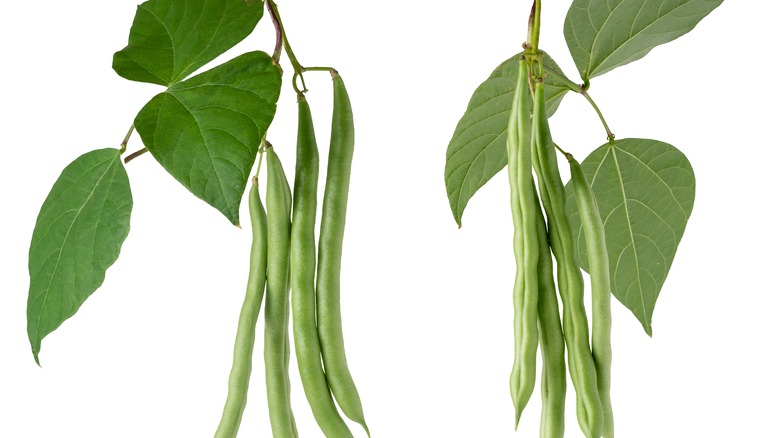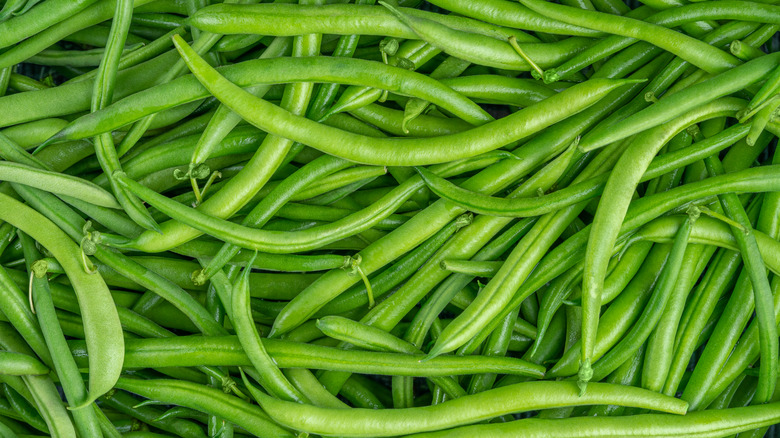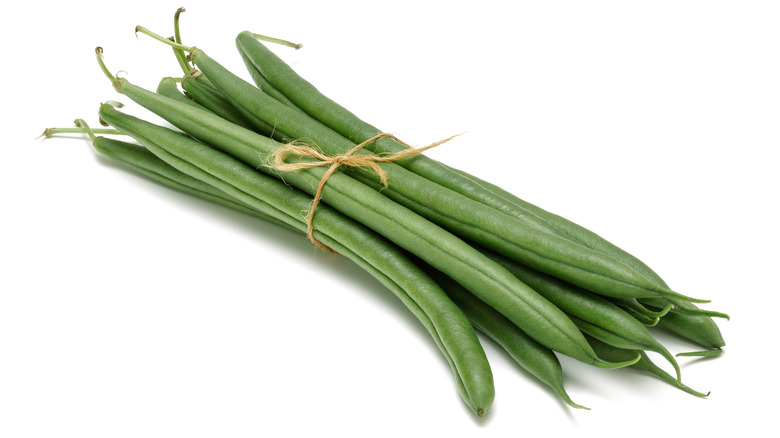String Vs French Green Beans: What's The Difference?
String beans, snap beans, French green beans — you've definitely seen them and have probably eaten them, but you might not be able to tell what the differences are between them. Before diving into what sets the different breeds apart, though, it's important to understand their commonalities. Often referred to with the catch-all term "green beans" in America, these vegetables are ubiquitous in modern supermarkets, showing up throughout store aisles in the forms of fresh, frozen, and canned green beans to suit the recipes and tastes of a vast range of diners. Despite the fact that many might just see them as slender, crunchy vegetables, there are actually about 130 varieties of green beans throughout the world that come in different shapes, sizes, and colors.
Haricot beans, a cousin of the modern green bean, were domesticated and harvested by Central and South American natives for thousands of years. They are the unripened fruits of the common bean bush known as Phaseolus vulgaris, and different from other beans in that they are picked and cooked along with their pods. When green beans are left too long on the bush, the beans swell up and the pods become inedible; thankfully, early cultivators noticed this and started breeding them to be deliciously tender in their unripened stage resulting in the vast family of green beans that we enjoy today. Now that you know what makes a green bean a green bean, it's time to break down the differences between string and French.
What are string beans?
String bean is a term you might hear being used, but how does it differ from green beans? In fact, they don't differ at all. They're unripened pods that get harvested with the undeveloped seeds inside, they're green, and they have the same signature shape. The name string bean is an outdated misnomer that has stuck around since the 19th century, back when most varieties of green beans contained a long, fibrous strand running through the length of the pod. In 1897 in Le Roy, New York, bean breeders eliminated this inconvenient string that used to occur naturally, effectively rendering the term 'string bean' useless. Nevertheless the name has endured, and the stringless green bean has grown to become one of America's most common garden vegetables.
If you're a particular fan of standard string beans, or want to start growing them in your garden, rest assured that there are many ways to cook and eat them. From blanching to roasting to pickling, string beans are a very versatile vegetable. Arguably the best way to enjoy the natural flavor and texture of string beans is to steam them briefly on the stove or in the microwave. Once they're tender and cooked, you can sprinkle on some salt and pepper, add a pat of butter, and toss it all together. In addition to being a simple and quick process, steaming also helps preserve the nutritional content of the beans better than if they were boiled.
What are French green beans?
Inevitably, if you've bought packaged fresh green beans at the supermarket, you've been confronted with the choice of whether to buy the standard variety or French green beans. Typically, French green beans are more expensive than standard green beans, so what are you really getting for your money?
Also known as Haricots Verts, these particular green beans are the result of French farmers tinkering with the original pods they would receive from the Americas to suit their culinary tastes. The resulting beans are now known for being thinner and longer than the average American-grown green bean. They also have a reputation for being more tender and flavorful, making them the more premium choice of green bean. They were commonly used as accompaniments to entrées in French haute cuisine throughout the twentieth century, cementing the bean's status among gourmands. Today, this variety is grown all over the world and can be found in colors ranging from green to yellow and even purple.
French green beans can be prepared in either hot or cold dishes. To add crunch and flavor to a salad, you can blanch these beans quickly in salt water and then stop the cooking in an ice bath before chopping them up and sprinkling them over your greens. For a hot, savory application, try sauteing them in butter with shallots for a French-inspired side to your next roast chicken dinner.


